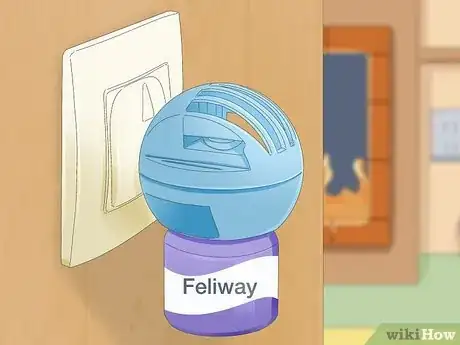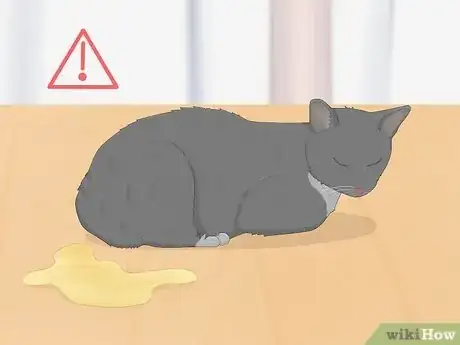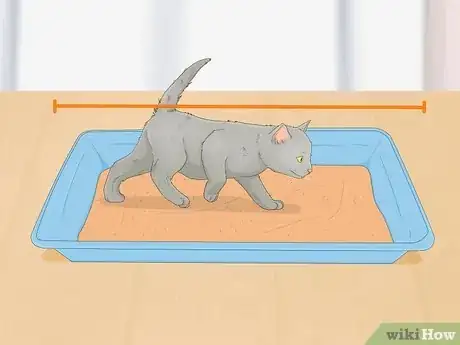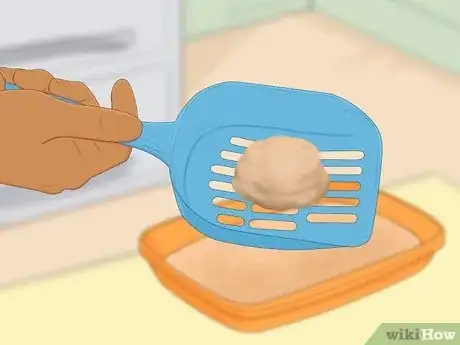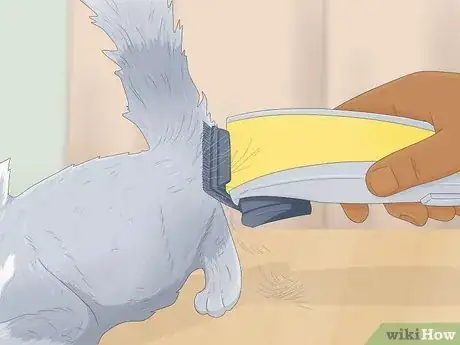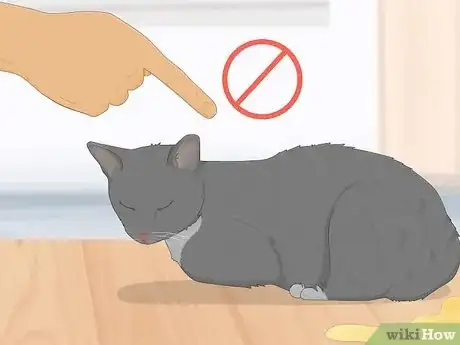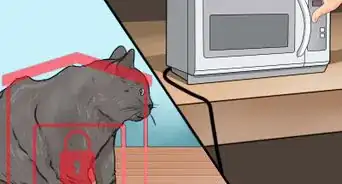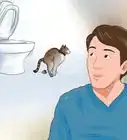This article was co-authored by Tabitha Kucera. Tabitha Kucera is a Registered Veterinary Technician & Cat and Dog Behavior Consultant and the Owner of Chirrups and Chatter Cat and Dog Behavior Consulting and Training in Cleveland, Ohio. Tabitha has over ten years of experience working at animal veterinary hospitals, farm sanctuaries, and cat and dog rescue centers. Tabitha has helped to develop training and behavior programs for various veterinary hospitals and shelters and works as a consultant for many shelters and private veterinary practices. Her teaching credentials include lecturing at regional and national levels and at multiple veterinary technology programs. She is a Fear Free certified speaker, a Fear Free Practice Certification Consultant, a behavior consultant for Cat Pawsitive Pro, and host of the podcast, Tails from a Vet Tech. She currently serves on the board of the Pet Professional Guild’s Cat Committee and is the President of the Society of Veterinary Behavior Technicians. She is an Elite Fear Free and Low-Stress Handling Certified Registered Veterinary Technician, a certified cat behavior consultant, a Karen Pryor Academy certified training partner, and has a Veterinary Technician Specialist (VTS) designation in behavior.
wikiHow marks an article as reader-approved once it receives enough positive feedback. In this case, 100% of readers who voted found the article helpful, earning it our reader-approved status.
This article has been viewed 483,757 times.
There are many reasons why your cat may be urinating where it shouldn’t. Cats may stop using the litter box as a result of stress, a medical condition, or simply because the box is not cleaned often enough. Depending on the cause of your cat’s issues with the litter box, you may need the help of a veterinarian. There are several things that you can do to encourage your cat to use the litter box instead of a rug or a piece of furniture. You can try a new type of box or litter, clean the box more often, play with your cat near the box, add more litter boxes, and do things to discourage your cat from urinating outside of the box. Keep reading to learn more about how to keep your cat from urinating where it shouldn’t.
Steps
Understanding Common Litter Box Problems
-
1Consider how often you clean the litter box. Cats do not like to use a dirty litter box and they may begin going to the bathroom elsewhere if their litter box is dirty when they need to go. If you are not cleaning your cat’s litter box every day, this may be the reason that your cat is urinating where it shouldn’t.[1] [2]
- In addition to scooping out your cat’s litter box every day, once per week you should also remove all the litter and clean the box with warm water and unscented soap or baking soda. When you are finished, dry the box and add fresh litter.
-
2Count the number of litter boxes in your house. It is important to have one more box than the number of cats in your household. For example, if you have three cats, then you should have four litter boxes. If you only have two litter boxes and you have three cats, then the number of litter boxes may be the cause of your cat’s refusal to use the litter box.[3]Advertisement
-
3Determine if your cat can access the litter box with ease. If your cat has to make a long trip to get to her litter box or if the litter box itself is difficult for your cat to get into and out of, that might be the reason why your cat is urinating where she shouldn’t. Place your cat’s litter boxes where it is easy for her to get to them in a hurry, such as one upstairs and one downstairs.[4] [5]
- Make sure that your cat will be able to see approaching humans or animals and easily get away. Cats don’t like to feel cornered
- Attend to the needs of older cats by providing boxes with lower sides, for easier entrance and exit to the litter box.
- Place litter boxes near where your cat tends to urinate most often.
-
4Find out if the litter you use is causing the problem. Cats may avoid using the litter box because they dislike the smell or texture of the litter, or because the litter box is too full. A shallow bed of medium to fine grain clumping litter is best, but you can also try offering your cat different types of litter to see what she prefers.[6]
- Give your cat a choice of litter types by placing two litter boxes with two different types of litter right next to each other. At the end of the day, check to see which one your cat used.
- Provide a shallow bed of litter. Most cats prefer a litter box that has about 1–2 inches (3–5 cm) of litter.
-
5Determine if the litter box may be causing your cat discomfort. Some cats avoid using a litter box because they don’t like the size or shape of it. Liners may also cause your cat discomfort that can make her avoid the box. Remove the liner and hood from your cat’s litter box to determine if they are what is causing her to avoid using the box.[7]
- Consider the size of your cat’s litter box as well. If it is too small for her, then she may avoid using it.
Considering Possible Health and Behavior Problems
-
1Decide if stress may be a factor in your cat’s litter box issues. Other pets, children, or a noisy environment can all cause your cat to feel stressed and avoid the litter box. Make sure that your cat’s litter box is kept in a place that is semi-dark, quiet, and secluded. If your cat’s box is in a high traffic area, she will be less likely to use it.[8] [9]
- Try using Feliway diffusers to help your cat feel more relaxed. This product releases a scent that some cats may find comforting.
-
2Consider your cat’s current or past medical conditions. Your cat’s medical history may provide an explanation for why your cat has not been using the litter box. If you suspect that your cat is sick, take her to see a vet as soon as possible. Early treatment of an illness by help stop litter box problems as well as save your cat from pain and discomfort. Urinary tract infections and feline interstitial cystitis are common conditions that may cause your cat to urinate outside of the litter box.[10]
- Urinary tract infections may cause a cat to avoid the litter box, even after the infection has been treated. Your cat may still associate the litter box with pain and want to avoid it.
- Feline interstitial cystitis is another common cause of litter box aversion. Cats with feline interstitial cystitis may urinate in the litter box because they feel the need to urinate more often.
- Kidney stones or a blockage of your cat’s urinary tract may also result in litter box aversion. Your cat may meow or howl while using the box and the fear of pain may continue even after treatment.
- Keep in mind that prompt treatment of these conditions is essential so that your cat does not develop a long lasting litter box aversion.[11]
-
3Figure out if urine marking is the cause of your cat’s litter box problems. Urine marking is when your cat sprays a bit of urine on a piece of furniture or other surface to mark her territory. The amount of urine is much less than a cat will eliminate when urinating. If your cat is displaying this type of behavior, many of the suggestions in this article will be helpful, but there are additional things that you will need to do to help stop your cat from urine marking.[12]
- Urine marking is most common in unneutered male cats but unspayed female cats may also exhibit this behavior, so it is important to have your cats spayed and neutered.
- Urine marking is also common in households with more than ten cats, so keeping the number of cats in your home below ten can also help with this problem.[13]
Stopping Your Cat from Urinating Where It Shouldn’t
-
1Create an accessible litterbox setup for all of your cats. Put plenty of litterboxes around your home—a good rule of thumb is to have a litterbox for every cat plus an additional one (e.g., 3 litterboxes for 2 cats). Place the litterboxes throughout the home, including all levels of the home (keep in mind that 3 litterboxes next to each other are just 1 litterbox from a cat's perspective). If a cat, dog, or human is blocking the pathway (either purposefully or accidentally), the cat should have another option available.
- Cats do not like litterboxes placed in closets or other areas with one entrance and exit, as these are considered ambush areas.
- You can plug in a nightlight near a litterbox if it's in a dark area.
- Older cats and cats with medical issues that cause them to go to the bathroom frequently require easy access to a litterbox.
- Many cats prefer to defecate in one box and urinate in another.
-
2Make sure that the litterboxes are 1.5 times longer than the length of your cat. Your cat should be able to comfortably turn around in a litterbox—you wouldn't want to use an airplane-sized bathroom, and neither does your cat! Jumbo-sized litterboxes or plastic, under-the-bed storage containers often make good box options for adult cats and multi-cat households. Uncovered boxes are also strongly recommended.
-
3Maintain the litterboxes regularly and wash them every 4-6 weeks. Take time to scoop the litterboxes daily. Once every few weeks, dump and wash the litterboxes with mild soap (avoid strong, aversive cleaning agents like bleach). Offer a clumping clay litter that's unscented and dust-free (or low dust), as most cats prefer this over other types of litter.
- Ultimately, let your cat choose which litter they prefer. If your cat prefers a specific litter, do not change it.
-
4Manage the behavior by identifying and minimizing your cat's triggers. If outside cats seem to be the stimulus for marking behavior, minimize exposure to them by keeping window blinds closed. If they're urinating on clothing, put the clothing away instead of on the floor. It also helps to place shoes, backpacks, and luggage with unfamiliar odors off the floor and out of your cat's reach.
- Monitor your cat's behavior and positively redirect it if you suspect that they had an accident. This can involve tossing a toy, calmly calling their name and petting them, or tossing a treat.
-
5Change the function of the area where they urinate frequently. If your cat pees a lot in a certain room, move some bedding, scratching posts, grooming toys, or other toys to the area. Give olfactory enrichment, puzzle toys, and play times in those areas, too!
-
6Clean accidents with an enzymatic cleaner. Cleaning up accidents right after they happen will also help deter your cat from using the same spot again. Use an enzymatic cleaner rather than an ammonia-based one. Ammonia-based cleaners may cause your cat to urinate more often on the spot because she may interpret the ammonia as another cat’s urine that she must cover up with her own urine.[14] [15]
-
7Get your cat's long hair around their hind quarters trimmed. If you have a long-haired cat, she may have an aversion to the litter box because she feels dirty after using it. Visiting the groomer and keeping your cat’s hair trimmed may help her to use the litter box. You may also need to get her bathed to make sure that she does not smell like urine or feces.[16]
-
8Play with your cat around her box. Negative associations with the litter box may be improved by doing things like playing with your cat around the litter box. Try playing with your cat a few feet away from her box a few times per day to help generate more positive feelings about the litter box.
- Do not try to reward your cat for using the litter box by giving her treats. Cats don’t like to be disturbed while they use the litter box.[17]
- You can leave treats and toys near your cat’s litter box, but do not keep your cat’s food and water dish next to her box. Cats don’t like to eat too close to where they use the bathroom.
-
9Avoid punishing your cat for urinating. Your cat isn't being spiteful—they're missing the box due to medical and/or behavioral concerns such as stress or not feeling safe around their litterbox. Punishing your cat for this behavior can result in more fear and stress and can also damage your relationship with them.
- Punishment does not teach your cat what you want; instead, it can result in them urinating in a place that you can't find.
-
10Talk to your veterinarian if things don’t improve. Encouraging your cat to use the litter box takes time and effort, but it may not always be successful. Some veterinarians undergo special training to help people deal with problems such as urinating outside of the box. If your cat does not improve over time, consider speaking to a Certified Applied Animal Behaviorist or a board-certified veterinary behaviorist.[18]
Expert Q&A
Did you know you can get expert answers for this article?
Unlock expert answers by supporting wikiHow
-
QuestionHow do I keep my 16 year old bengal cat from urinating on the couch?
 Pippa Elliott, MRCVSDr. Elliott, BVMS, MRCVS is a veterinarian with over 30 years of experience in veterinary surgery and companion animal practice. She graduated from the University of Glasgow in 1987 with a degree in veterinary medicine and surgery. She has worked at the same animal clinic in her hometown for over 20 years.
Pippa Elliott, MRCVSDr. Elliott, BVMS, MRCVS is a veterinarian with over 30 years of experience in veterinary surgery and companion animal practice. She graduated from the University of Glasgow in 1987 with a degree in veterinary medicine and surgery. She has worked at the same animal clinic in her hometown for over 20 years.
Veterinarian If the cat has previously been clean and this is a new habit, then a vet check up is a good idea. At 16 years it might be the cat has a health problem which is causing them to drink more and then pee more. It's interesting that the preferred location is the sofa because this is strongly linked to your presence and the scent will be strongly reassuring for the cat. Thus, in a back-handed compliment the cat is toiletting on the sofa as they feel safe there. Before assuming this is behavioral the cat should be checked by a vet.
If the cat has previously been clean and this is a new habit, then a vet check up is a good idea. At 16 years it might be the cat has a health problem which is causing them to drink more and then pee more. It's interesting that the preferred location is the sofa because this is strongly linked to your presence and the scent will be strongly reassuring for the cat. Thus, in a back-handed compliment the cat is toiletting on the sofa as they feel safe there. Before assuming this is behavioral the cat should be checked by a vet. -
QuestionWe have 4 cats that have access to outdoors, but last year, two of them started fighting, and now accidents happen in the house. Offering a litter tray made no difference, and they still pee in certain places. What can I do?
 Pippa Elliott, MRCVSDr. Elliott, BVMS, MRCVS is a veterinarian with over 30 years of experience in veterinary surgery and companion animal practice. She graduated from the University of Glasgow in 1987 with a degree in veterinary medicine and surgery. She has worked at the same animal clinic in her hometown for over 20 years.
Pippa Elliott, MRCVSDr. Elliott, BVMS, MRCVS is a veterinarian with over 30 years of experience in veterinary surgery and companion animal practice. She graduated from the University of Glasgow in 1987 with a degree in veterinary medicine and surgery. She has worked at the same animal clinic in her hometown for over 20 years.
Veterinarian If the accidents started since the cats stopped getting along, then this might be a case of territory marking. Key to resolving the problem is getting rid of any existing odor (clean the patch daily for at least 2 - 3 weeks after the last accident) and decrease stress between the cats. Do this by providing high perches, hiding places, separating their food bowls so they each have their own food in separate locations, and providing 2 routes through each room so they can avoid each other. Do not tell the cats off, as this increases their stress.
If the accidents started since the cats stopped getting along, then this might be a case of territory marking. Key to resolving the problem is getting rid of any existing odor (clean the patch daily for at least 2 - 3 weeks after the last accident) and decrease stress between the cats. Do this by providing high perches, hiding places, separating their food bowls so they each have their own food in separate locations, and providing 2 routes through each room so they can avoid each other. Do not tell the cats off, as this increases their stress. -
QuestionMy female cat never peed outside the box until last month. Now she uses a spot on the carpet not far from the box. We've cleaned the area and she doesn't soil there every day, just in spells. What can we do?
 Pippa Elliott, MRCVSDr. Elliott, BVMS, MRCVS is a veterinarian with over 30 years of experience in veterinary surgery and companion animal practice. She graduated from the University of Glasgow in 1987 with a degree in veterinary medicine and surgery. She has worked at the same animal clinic in her hometown for over 20 years.
Pippa Elliott, MRCVSDr. Elliott, BVMS, MRCVS is a veterinarian with over 30 years of experience in veterinary surgery and companion animal practice. She graduated from the University of Glasgow in 1987 with a degree in veterinary medicine and surgery. She has worked at the same animal clinic in her hometown for over 20 years.
Veterinarian Sadly, there's cleaning... and there's cleaning effectively. Behaviorists recommend thoroughly deodorizing every day until the cat has not used the spot for 2 - 3 weeks (so at least 14 cleanings in a row!) It might be something spooked her in the original tray, so try offering another tray that's similar but not identical, near to the spot she has currently chosen. Try putting her food on the offending spot, as she's less likely to soil where she eats.
Sadly, there's cleaning... and there's cleaning effectively. Behaviorists recommend thoroughly deodorizing every day until the cat has not used the spot for 2 - 3 weeks (so at least 14 cleanings in a row!) It might be something spooked her in the original tray, so try offering another tray that's similar but not identical, near to the spot she has currently chosen. Try putting her food on the offending spot, as she's less likely to soil where she eats.
Warnings
- Do not rub your cat’s nose in the urine, pick her up and put her in the box, or confine her to a small room. These measures will not solve the problem and they may even make it worse by creating more negative associations with the litter box.[20] [21]⧼thumbs_response⧽
- Do not use an ammonia based cleaner to clean up your cat’s urine. Using this type of cleaner may increase your cat’s urge to urinate on that spot again.[22]⧼thumbs_response⧽
Expert Interview

Thanks for reading our article! If you'd like to learn more about controlling cats' behavior, check out our in-depth interview with Tabitha Kucera.
References
- ↑ https://www.aspca.org/pet-care/virtual-pet-behaviorist/cat-behavior/litter-box-problems
- ↑ http://pets.webmd.com/cats/guide/solving-cat-litter-box-problems?page=2
- ↑ https://www.aspca.org/pet-care/virtual-pet-behaviorist/cat-behavior/litter-box-problems
- ↑ http://pets.webmd.com/cats/guide/solving-cat-litter-box-problems?page=2
- ↑ https://www.aspca.org/pet-care/virtual-pet-behaviorist/cat-behavior/litter-box-problems
- ↑ http://pets.webmd.com/cats/guide/solving-cat-litter-box-problems?page=2
- ↑ https://www.aspca.org/pet-care/virtual-pet-behaviorist/cat-behavior/litter-box-problems
- ↑ https://www.aspca.org/pet-care/virtual-pet-behaviorist/cat-behavior/litter-box-problems
- ↑ http://pets.webmd.com/cats/guide/solving-cat-litter-box-problems
- ↑ https://www.aspca.org/pet-care/virtual-pet-behaviorist/cat-behavior/litter-box-problems
- ↑ http://www.humanesociety.org/animals/cats/tips/solving_litter_box_problems.html
- ↑ https://www.aspca.org/pet-care/virtual-pet-behaviorist/cat-behavior/litter-box-problems
- ↑ https://www.aspca.org/pet-care/virtual-pet-behaviorist/cat-behavior/urine-marking-cats
- ↑ https://www.aspca.org/pet-care/virtual-pet-behaviorist/cat-behavior/litter-box-problems
- ↑ http://www.humanesociety.org/animals/cats/tips/solving_litter_box_problems.html
- ↑ https://www.aspca.org/pet-care/virtual-pet-behaviorist/cat-behavior/litter-box-problems
- ↑ http://pets.webmd.com/cats/guide/solving-cat-litter-box-problems?page=3
- ↑ https://www.aspca.org/pet-care/virtual-pet-behaviorist/cat-behavior/litter-box-problems
- ↑ http://pets.webmd.com/cats/guide/solving-cat-litter-box-problems?page=2
- ↑ http://pets.webmd.com/cats/guide/solving-cat-litter-box-problems?page=3
- ↑ http://www.humanesociety.org/animals/cats/tips/solving_litter_box_problems.html
- ↑ http://pets.webmd.com/cats/guide/solving-cat-litter-box-problems?page=3
About This Article
To keep your cat from urinating where it shouldn’t, make sure you clean the litter box at least 1 time a day, and wash it with baking soda at least 1 time a week. Make sure you always have 1 litterbox per cat, plus an extra one for them to use in a hurry since they don’t like sharing. If the cat still isn’t using the litterbox, try removing the liner and hood to make it easier to use, and start using a different type of litter to see if the cat just doesn’t like how it smells. For tips from our Veterinary reviewer on ruling out stress and health problems, read on!





